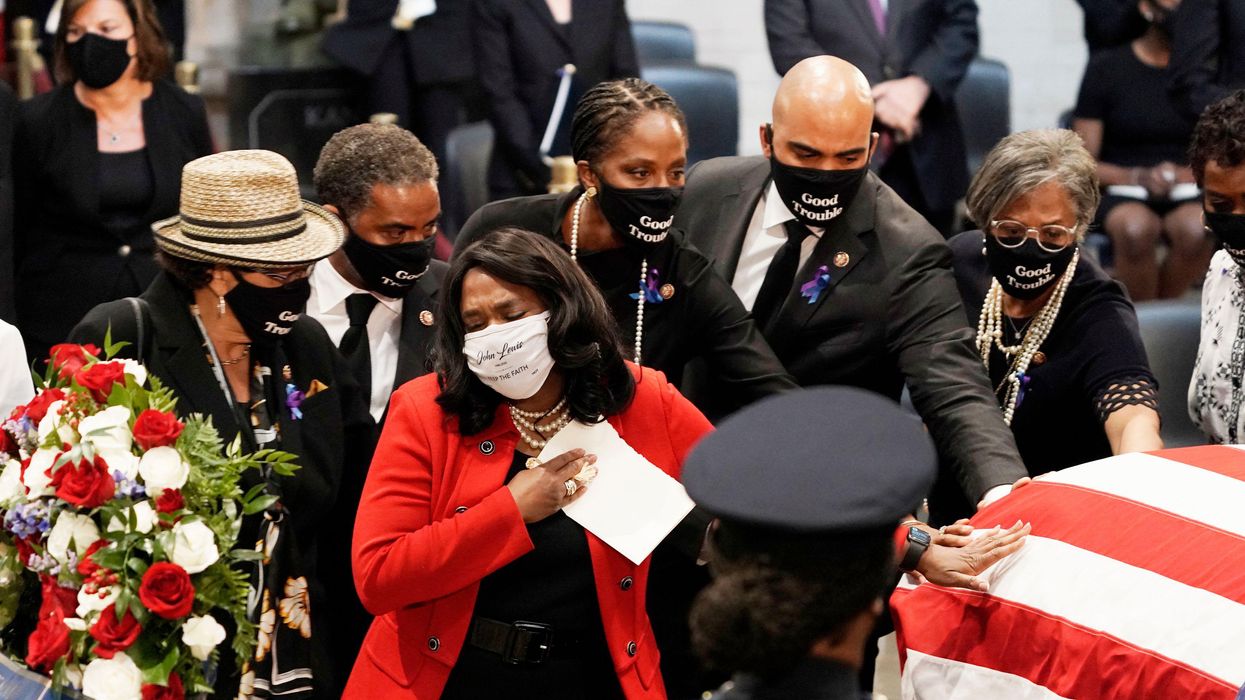Originally published by The 19th
Standing next to the Edmund Pettus Bridge on Tuesday, Rep. Terri Sewell of Alabama introduced House Resolution 4, the John R. Lewis Voting Rights Advancement Act, for the fourth time.
As the country marks 101 years since the ratification of the 19th Amendment on Wednesday, the franchise remains fragile. Women of color like Sewell are on the front lines of fighting the 21st century voter suppression efforts sweeping state legislatures — and of helping to lead the push for federal voting rights legislation that is likely to stall anew in a deeply divided Congress.
In the modern-day battle for suffrage, many women and marginalized people are fighting on two fronts: They're attempting to defend hard-fought gains even as they scramble to expand the electorate. Some see the progress of the past imperiled as their successes are met with conservative backlash.
The suffrage anniversary raises questions of who is American, who gets to have a say and who gets to participate in our democracy, said Notre Dame University political scientist Christina Wolbrecht.
“This is a broad fight about who deserves to have power in this country," said Wolbrecht, author of the book “A Century of Votes for Women." “People do not like to lose status."
Last year's suffrage centennial was a stark reminder of the people who were excluded from that victory in 1920: the Black women who stood shoulder to shoulder with White suffragists, only to be sacrificed as the latter group prioritized their race over gender; Latinas and Asian women who were blocked from the ballot with discriminatory language restrictions; Native Americans who were not yet even recognized as American citizens. Suffrage remains a work in progress for so many, including transgender Americans who face barriers at the polls.
Today, women are the majority of the U.S. electorate, and Black women are the most loyal and consistent voters in the Democratic Party. A record number of women and LGBTQ+ people serve in Congress and the current administration, including several who hold pioneering leadership positions.
Vice President Kamala Harris has used her bully pulpit as the second-most powerful person in the country to push for increased voter participation and to call for the passage of federal voting rights legislation to counter state suppression efforts. And she has met with civil rights leaders, including women like Black Voters Matter co-founder LaTosha Brown, Janet Murguia of UNIDOS and NAACP Legal Defense Fund President Sherrilyn Ifill, who are urging federal action on the issue as their focus shifts from campaigning to holding elected officials accountable.
In the Justice Department, two women of color are tasked with enforcing voting rights. Vanita Gupta is the agency's third-highest-ranking official, and Kristen Clarke oversees the department's federal civil rights division.
In the first seven months of the administration, the DOJ has announced plans to expand civil rights enforcement, sued Georgia over its elections bill and launched an investigation into allegations of discriminatory policing practices in Phoenix.
The suffrage centennial in 2020 also coincided with a push to suppress voters in the midst of a pandemic. As lots of voters turned to absentee voting as a COVID-friendly way to cast a ballot, Republican lawmakers in many states sought to limit the number of drop boxes available in communities and to shorten the window for early voting — tactics that made voting more challenging.
Still, Black women in particular helped to organize and turn out record numbers of voters in November, many of whom stood in long lines at risk to their public health to participate in the 2020 election. They turned out again to deliver the Senate to Democrats in January special elections. Latinas were also part of a winning coalition for Democrats, with organizing efforts that led to critical victories in states like Nevada and Arizona last fall.
For Black women, as with the original suffragists, their efforts were tied to support and advocacy for their communities on issues including health care, education, the economy and inequality.
Melanie Campbell, head of the National Coalition on Black Civic Participation, was among several Black women arrested last month on Capitol Hill at a protest pushing for the passage of Senate Bill 1, the For the People Act, before the legislation died earlier this summer.
The bill, which would've limited the influence of money in politics and protected access to the polls, failed to gain Republican support. Democrats were unwilling to jettison the filibuster to unilaterally pass the bill into law. Campbell and other civil rights leaders have met with the administration and attempted to appeal to Democratic holdout Sen. Joe Manchin of West Virginia.
Much of the work Campbell does echoes that of Black women suffragists dating back to her Delta Sigma Theta sorority sisters who marched for voting rights more than a century ago. That she follows their example has been both discouraging and inspiring.
“The fight for inclusion never ends," Campbell said. “It can be burdensome, but we have to keep doing it. If we lose this battle, we lose our fight to build power and for self-determination."
The House is expected to vote on H.R. 4, the John Lewis Voting Rights Advancement Act, when Congress resumes on August 23, but the legislation continues to face long odds in the Senate.
Ifill said the country is at a critical juncture when it comes to voting rights.
“Failure is not an option because the stakes are so high," Ifill said in a conversation for The 19th Represents, a virtual summit taking place this week. The full conversation airs on Friday.
“The voter suppression that we have seen over the last few months is in direct response to the extraordinary mobilization of voters that happened last year and the turnout," she added. “Litigation will not do it alone. Organizing can't do it alone. We need this legislation."
































